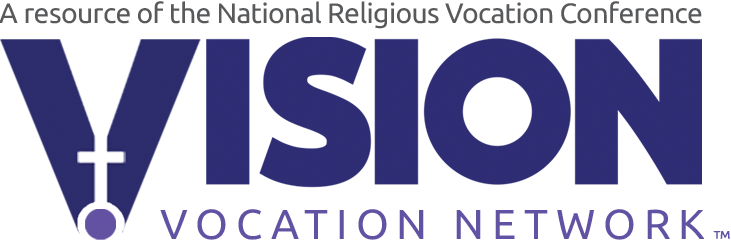Icons: An age-old entrée into the divine
![]()
Father Michael Shrum, O.S.B. with the icon he created of Saint Benedict. (Photo courtesy of Mount Angel Abbey)

FOR CENTURIES, the art of iconography has had a rich tradition in the Catholic Church, serving as a powerful way for the faithful to connect with the divine. The late priest and author Henri Nouwen wrote, “An icon is like a window looking out upon eternity.” The unusual proportions of the figures and strange pictorial perspectives, alone, appear otherworldly and are ripe with religious symbolism. These striking artworks are also visual reminders of the life of Jesus and his teachings that can help us connect more intimately with God through prayer and contemplation.
Sacred imagery holds a central place in our faith, offering a doorway to the stories of the Bible and beyond. While we might admire the beauty of an aesthetically pleasing sculpture, the tradition of iconography calls for more active participation from the people who create icons and those who pray with them, drawing individuals into a profound encounter that transcends aesthetics. The icon’s role as a sacred art form invites us to explore the images through the lens of holy and theological understanding.
Layers of meaning
Everything from color and composition to value and linework becomes a beacon to unraveling the mysteries of the icon and, in turn, our faith. Each stage of the painting and the materials used are all imbued with divine symbolism. In some forms of iconography, for example, iconographers use their breath to moisten the red clay on their board to apply thin sheets of gold leaf. The process calls to mind how God created Adam from the dust of the Earth and breathed life into him. Using gold symbolizes the brilliance of God’s divine glory and heavenly Kingdom.
Other symbolism, such as crosses, scrolls, and stars, are keys to deciphering the identity of each figure and scene. Martyrs, for instance, are often depicted wearing red robes and holding crosses. Icons of the Mother of God with the Christ child often feature Jesus with an enlarged head to signify he has the wisdom of God. Saints can be identified by the items they carry. For instance, the Byzantine icon of Saint Mary Magdalene usually depicts her holding an alabaster jar, referencing the story of the woman who anointed Jesus’ feet with perfumed ointment.
“Icon” comes from the Greek word eikon, meaning “image.” This sacred art form was a source of controversy during the first millennium of the church (with opponents calling it idolatry), but it eventually became firmly entrenched in the Eastern Church and is now experiencing renewed popularity among Roman Catholics.
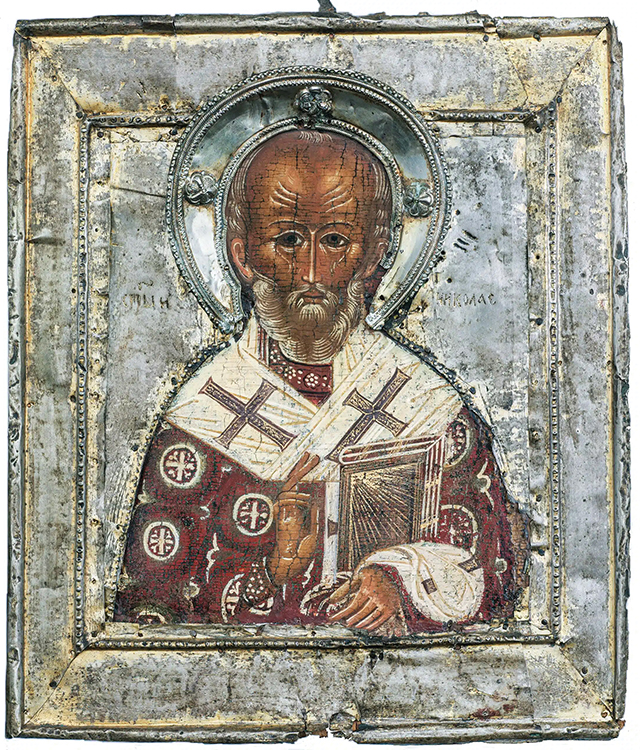
Christians have long used icons in their daily lives rather than treating them as untouchable objects. In ancient times, icons were paraded through the streets in times of war, carried in processions, fervently adored, held close for spiritual protection, and brought on long journeys by land and sea. Icons come in various styles, sizes, and forms, including panel paintings, mosaics, frescoes, and more.
Icons as a prayer portal
Eastern Orthodox Christians often have an “icon corner” in their homes that features traditional icons, including Christ and Mary. The images serve as an invitation to prayer, as we are reminded by the Catechism of the Catholic Church: “Genuine sacred art draws man to adoration, to prayer, and to the love of God, Creator and Savior, the Holy One and Sanctifier.”
Some find it helpful to recite traditional prayers, while others sit silently with icons. In his book Praying with Icons, author and theologian Jim Forest writes:
The icon is silent. No mouths are open nor are there any other physical details which imply sound. But an icon’s silence is not empty. The stillness and silence of the icon, in the home no less than church, create an area that constantly invites prayer. The deep and living silence which marks a good icon is nothing less than the silence of Christ. It is the very opposite of the icy stillness of the tomb. It is the silence of Mary’s contemplative heart, the silence of the transfiguration, the silence of the resurrection, the silence of the Incarnate Word.
Many who join religious communities consider praying with and creating icons essential for spiritual growth. Here are stories about several of these sisters, brothers, and priests.
Related article: VocationNetwork.org, “Inspired images.”
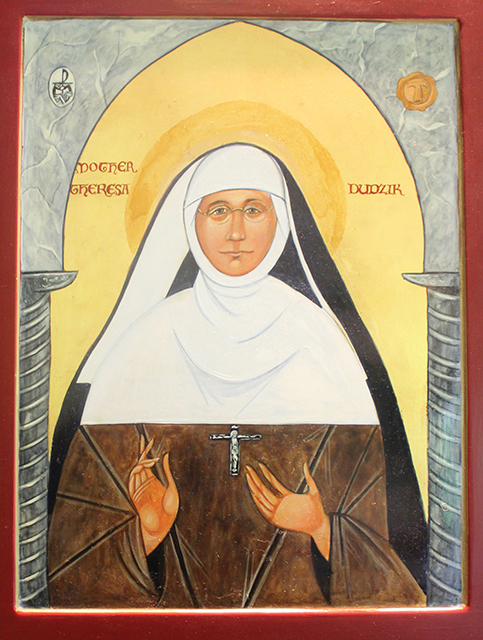
Icon captures social ministry hero
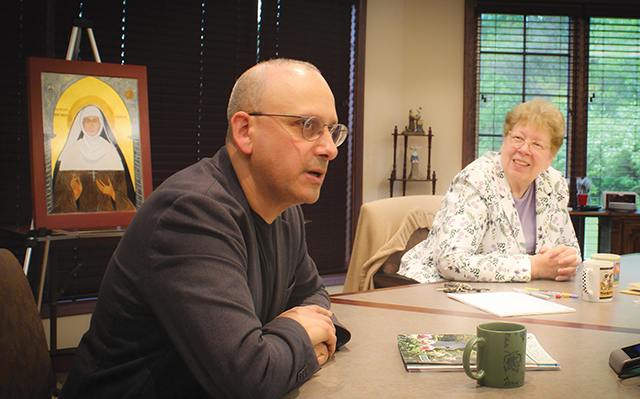
The Franciscan Sisters of Chicago were delighted in 2021 when they learned that artist and lay iconographer Joe Malham had created a portrait series of heroic Catholics of Chicago that included their foundress, Venerable Mary Theresa Dudzik. Dudzik dedicated her life to social and educational ministries for impoverished Chicagoans in the early 20th century, founding a religious community along the way.
The Franciscan community purchased a copy of the Dudzik portrait and then commissioned Malham to create an icon of her. It is now on display in Our Lady of Victory Convent in Lemont, Illinois.
On the community website, Malham explains details of the icon, including these: “There is an ethereal quality to Mother Mary Theresa as she is slightly out of proportion. The object is not to show the way she was human, but to illustrate her slightly elongated, which shows she’s been transformed into her divine state. She is then situated against a gold background, symbolizing God’s own created light.”

Instruments of prayer

Father Guerric Llanes, O.C.S.O., vocation director at California’s Abbey of Our Lady of New Clairvaux, explains that creating icons can cultivate humility. “The focus of the icon is not on the painter. And although an icon may be painted by my hand, the icon belongs to the church,” he says. Llanes always had an appreciation for art before monastic life and felt drawn to the beauty of Cistercian monastic architecture, noting the early Cistercian fathers’ emphasis on principles of harmony, austerity, simplicity, proportion, and light. Now he helps teach iconography to novices at the abbey. “Our novices learn how to prepare their own wooden boards and gesso and sand the surface to a smooth finish before they begin to work on the image they will paint on the board. Currently, our novices are working on the icon of the holy archangel Michael,” he explains.
“Icons are instruments of prayer,” Llanes continues. “And prayer is what facilitates conversation with God, listening to God intimately. So every time I work on an icon, my mind, heart, and hand are engaged in prayer.” He believes icons can be a helpful tool for someone discerning religious life. “When I sit to pray with scripture, I place an icon of our Blessed Mother or Christ before me. When it comes time to pause and ponder over the words of scripture, gazing into the icon mediates whatever God wants me to hear. I just have to be open and willing to receive that divine message.”

Vocation clarity before an icon
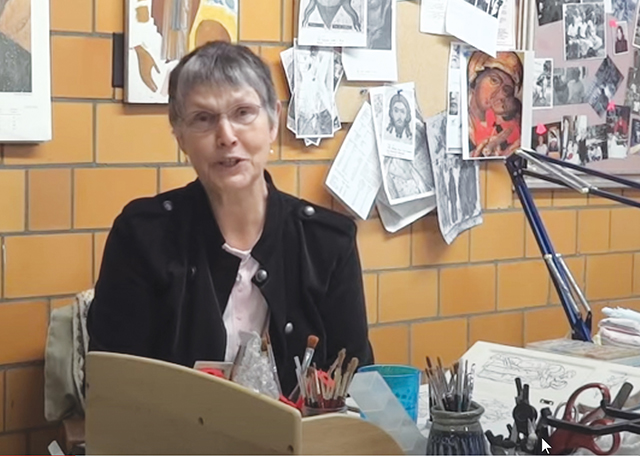
“You feel their presence when you’re working. They’re there with you,” says Sister Nancy Lee Smith, I.H.M. about the divine subjects of her icons. She has been a full-time iconographer for 30 years and studied with luminaries, including Ksenia Pokrovsky—a Russian Orthodox painter who helped revive classical iconography while it was still restricted in the Soviet Union. In 1957, Smith was a sculpture major at Webster College when she heard a call to religious life as she prayed before an icon of Our Mother of Perpetual Help for clarity on her vocation. That moment led her to join the Sisters, Servants of the Immaculate Heart of Mary in Monroe, Michigan and to experience a lifetime of interconnected moments with the divine through her iconography practice. “The whole thing has been a story between Joseph and the Mother of Perpetual Help,” she says. Saint Joseph is the namesake of her icon studio, as well as her late cat.
With additional degrees in English, theology, and a Master of Divinity degree—as well as icon installations in five countries and across the United States—Smith has spearheaded a prolific ministry as an iconographer. Though edging toward retirement, Smith still delights in explaining the stories and symbolism in her works. “The halo does not mean holiness,” she says of what may be the icon’s most recognizable symbol. “It’s contrary to what we think. The halo only means love. . . . The halo must break into the border, which means north, south, east, west. Because love will never be fenced in.”


Closer to Jesus
Brother Joseph Pio Young, C.F.R., at Our Lady of the Angels Friary in New York City, calls iconography a “tried-and-true way of growing in your relationship with Jesus. The closer you are to him, the better you’re going to know his will.” He was taught that the full-face view of the icons is “anticipatory of the face-to-face communion that we’ll have with God in heaven.”
Young was always drawn to art and spent a summer in Russia during college, where he became more familiar with iconography. He felt called to create an icon with acrylic paint after prayer and reflection during his postulancy, his early affiliation with his community. In novitiate—his formal preparation to become a friar—a fellow brother started teaching him the Prosopon School of Iconology style, which used the traditional methods of Byzantine iconography including egg tempera paint pigments. Learning the ancient art has been “spiritually enriching,” he says, and he has learned to trust the process—at the icon board and beyond. For Young, the icon’s dark, earthy base paint layer, called roskrysh, represents the chaos of creation and can look strange and mottled before the other paint layers complete the beautiful final picture. For Young, this mirrors the interior chaos people sometimes feel.
Of his relationship with the icons, he says, “It’s changed everything that I do in daily life. It’s brought me closer to prayer throughout the day.”

Icons provide guidance and inspiration
“It’s the gospel written on wood,” says Father Michael Shrum, O.S.B. of Mount Angel Abbey in Oregon (see photo at top of this article). “And that’s the verb that we use frequently. You can say we paint icons. And, sure, that’s true. But another way that we say it is that we write the icon because it’s writing the story of the gospel and the life of Christ and the lives of the saints in paint.” Shrum, a former archdiocesan priest who felt the call to join the abbey as a monk, started his journey with iconography after seeing art’s greatest masterpieces while studying in Italy. “Walking into churches and seeing the art as a catechism really helped me to grow in my faith,” he explains. During seminary at Mount Angel Abbey, he began studying iconography under the tutelage of Brother Claude Lane, O.S.B., who has been teaching the art form for more than 20 years.
Lane’s oldest icon, Christ the Teacher, hangs over the tabernacle at the abbey. In a poetic turn, the icon was written on an old tabletop previously used to prepare bread in the monastery kitchen. “That’s where I prepare for Mass,” Shrum says. “And to see the face of the Lord gazing upon us as we ponder his word, the word made flesh right there . . . that’s really at the heart of praying with an icon. . . . You can go deeper into the mystery.”
Mount Angel Abbey fosters a deep appreciation for iconography and art in several ways, including an exhibit of 22 icons written by Lane called The Salve Suite. “They have been purposely installed around the Abbey Hilltop in meaningful locations,” writes curator Father Nathan Zodrow, O.S.B. on the abbey website. “Together, they create a network of beauty and grace beckoning those of us living here and our guests to encounter the mysteries: to ‘seek things above.’ With each icon there is a story, a narrative, telling why it has emerged from our particular monastic culture and how it relates to the whole composition.”
Shrum says that even if people don’t fully understand the icons or feel moved by them initially, it is good to approach iconography with an open heart. He compares this to how a parent introduces a child to the faith and stresses the importance of having someone explain things. Shrum believes the icons can provide guidance and inspiration: “It’s a wonderful help to our prayer and in discerning what is God’s will for us. As we look to Christ and the saints, they’re always there beckoning us on to realize God’s plan for us.”

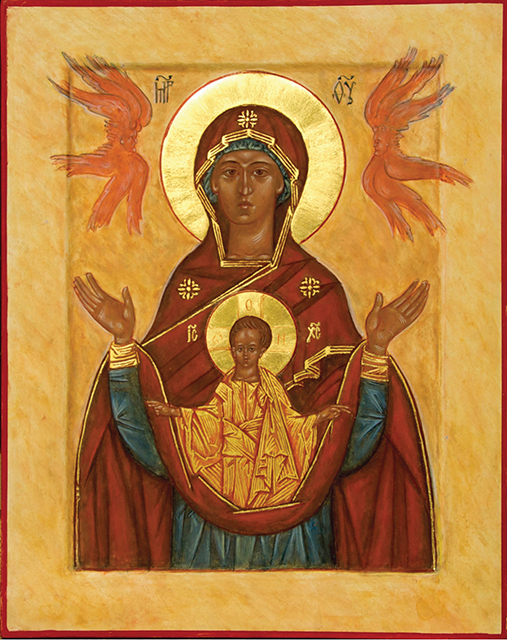
Mirror to the soul

Sister Suzanne Mattiuzzo, O.C.S.O., vocation director at Our Lady of the Redwoods Abbey in California, was formally trained by the Iconographic Arts Institute and Prosopon School of Iconology. She first explored iconography with a fellow Cistercian sister in Iowa who practiced the art and had an extensive library of books on the subject. “God speaks to people in many different ways. . . . I think in images,” she says. Mattiuzzo describes painting icons as “a devotion. It’s many things all rolled into one; it’s a conversation.” She says monastic life and its emphasis on lectio divina (a form of praying with scripture) is a natural match for the reflective, spiritually engaging act of icon painting.
She explains why someone discerning religious vows should consider icon painting or praying with icons: “An icon can bring you to contemplation just because of the way that it’s structured. A lot of it is based on sacred geometry. It reflects back to you in a way that touches your heart…. It’s a mirror to the soul.” She recalls an impactful teaching at the Prosopon School that echoes this: “As you’re painting your icon, the icon is getting painted in your soul.” This is the power and beauty of icons.
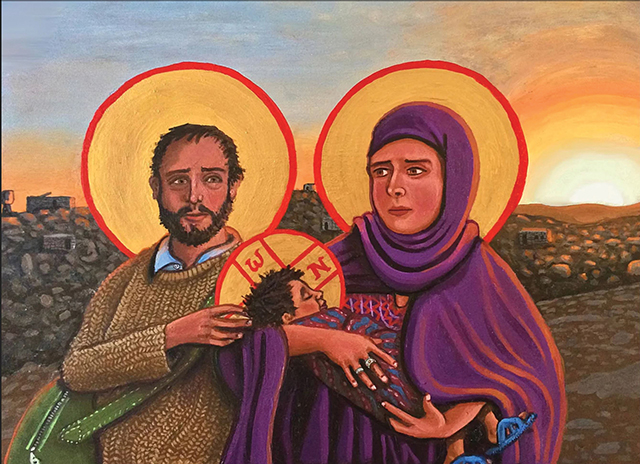
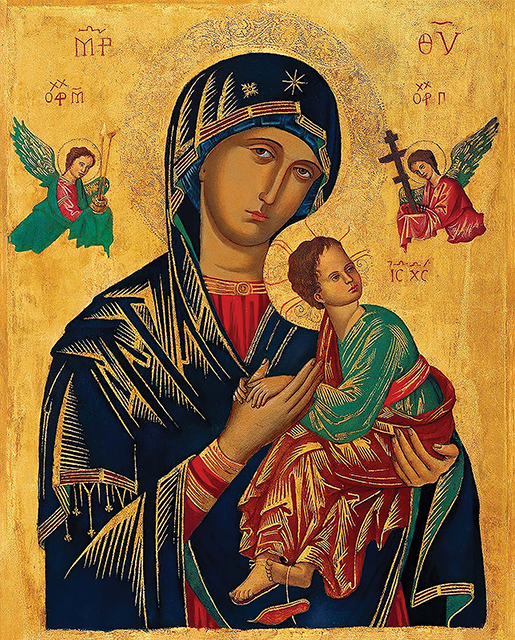

Tags
Related
- Literature makes good people better
- Religious communities have deep and diverse roots
- Scientific wonder is God’s handiwork
- Respite and renewal brought to you by religious communities
- Lives that lead to God: Biographies and memoirs
- Religious orders aid and advocate for migrants
- Rural religious take to the highways and byways
- Divine design: The holiness of place
- More prayer spaces of religious communities
- Word as witness to the Word Read More
Most Viewed
- Find your spirituality type quiz
- Questions and answers about religious vocations
- Celibacy quiz: Could I be a nun? Could I be a brother? Could I be a priest?
- Resources for older discerners or those with physical and developmental differences
- About Vocation Network and VISION Guide
